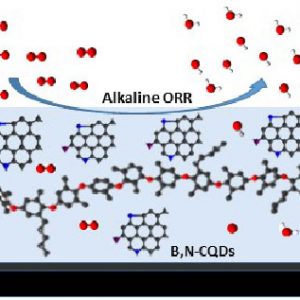Abstract
Nanocomposites containing B,N-codoped carbon quantum dots (CQDs) and an anion exchange ionomer based on poly(2,6-dimethylpolyphenyleneoxide) with trimethylammonium groups on long side chains (PPO-LC) were studied as catalytic electrodes for the oxygen reduction reaction (ORR). The objective was to reveal the impact of graphitic vs pyridinic/pyrrolic nitrogen on the ORR electrocatalysis. The CQDs were prepared by hydrothermal synthesis and analyzed by X-ray photoelectron spectroscpy to ascertain the B and N content and their position. The electrodes were prepared by drop-casting an ink of CQDs and PPO-LC on acid-treated carbon paper support. Characterizations of the electrodes included water contact angle, capacitance measurements, Fourier transform infrared spectra as well as scanning electron microscopy and optical microscopy. The onset and half-wave potentials, limiting current densities, Koutecky-Levich and Tafel plots revealed that the sample with only pyridinic/pyrrolic nitrogen showed the lowest electrocatalytic performance, underlining the importance of graphitic nitrogen for good ORR activity. Four-electron reduction was observed for the samples containing graphitic nitrogen. The onset potential (0.92 V/RHE) was among the best in the literature for carbonaceous materials. Finally, durability tests were performed indicating a good long-time stability of the electrodes; the electrode degradation was analyzed by impedance spectroscopy.
Illustrations
Details
Published on: JOURNAL OF THE ELECTROCHEMICAL SOCIETY.
Volume 171 Issue 6 DOI 10.1149/1945-7111/ad5872
Authors: Syahputra, S; Sgreccia, E ; Nallayagari, AR ; Vacandio, F ; Kaciulis, S ; Di Vona, ML ; Knauth, P
